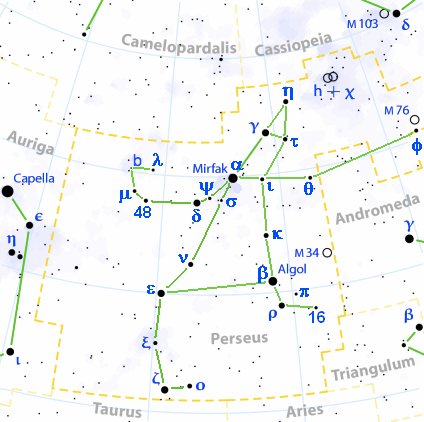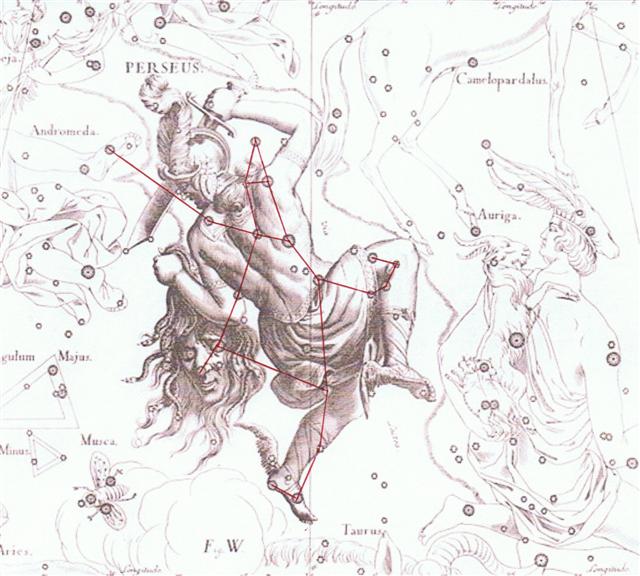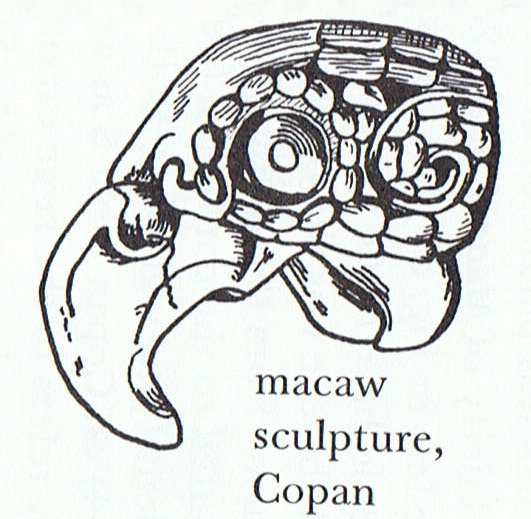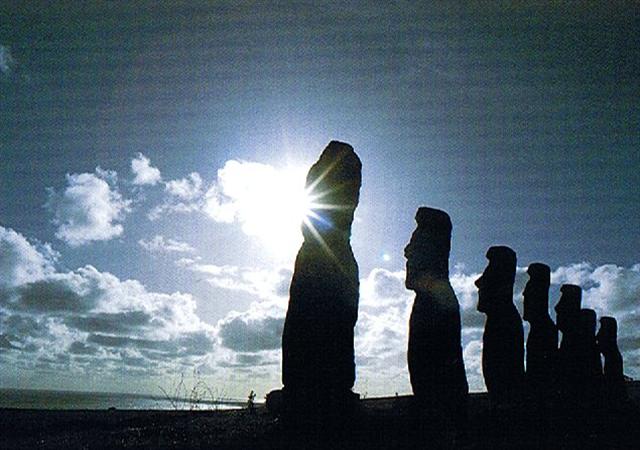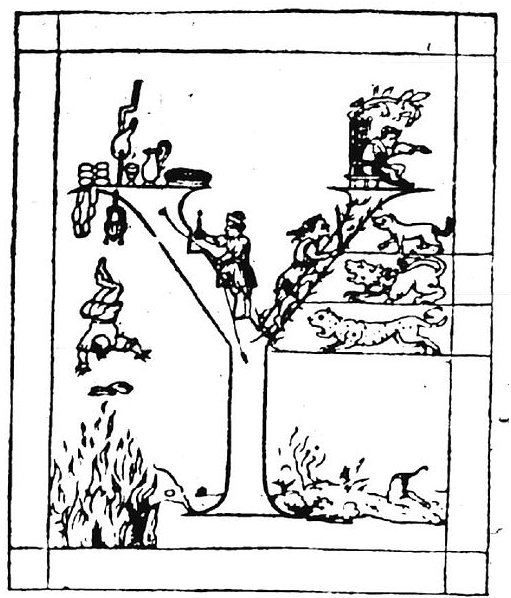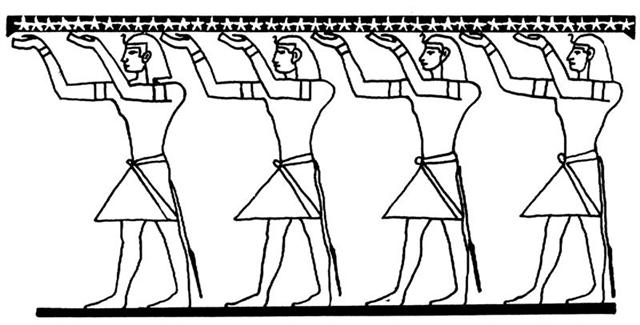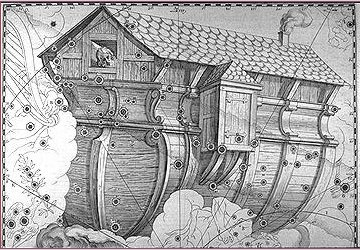457. The first 3-stone place was at the right Knee (48 → 12 * 29 - 300) of Perseus:
Counting with 9 dark weeks (e.g. from 0h to the end of side b of the G tablet) - possibly drawn as 3 * 3 black stones which Perseus was climbing over when releasing Andromeda from the winter monster (Cetus) -
we can find the first 3 stones in his left and right hands together with the central one in his red cap (pukao). ... Puna pau, a small natural well near the quarry where the 'hats' (pukao) were made; it was so called because only a little water could be drawn from it every day and it ran dry very soon ...
9 * 7 = 7 * 9 = 63 and together with 3 * 7 = 21 this makes 84 (12 weeks) as in the Julian day for spring equinox.
The Nose of the Sea Beast (Menkar, α Ceti) was below the ecliptic path of the Sun (and the other planets) but Andromeda and Perseus were up above in the Sky:
Henua curved to the left (like the back side of a hand) should be read in contrast to henua cupped like an open and inviting hand at Aldebaran, 3 weeks ('stones') later:
Here was upsilon Eridani, where dry land evidently was drawn up (waw, the 6th letter):
... That is the reason why this land, Aotearoa, is now so rough and mountainous and much of it so unuseful to man. Had the brothers done as Maui told them it would have lain smooth and flat, an example to the world of what good land should be. But as soon as the sun rose above the horizon the writhing fish of Maui became solid underfoot, and could not be smoothed out again. This act of Maui's, that gave our people the land on which we live, was an event next in greatness to the separation of the Sky and Earth ...
The separation of Sky and Earth came a week earlier, at upsilon Persei (*61), at the First 3-stone Place. ... On Stela C, however, the Quirigua scribes evoked a much more commonly used Creation image [than that of First Father emerging from the cracked carapace of a turtle shell] - that of 'three stone settings'. They named each stone, and told us who set them and where they were set, as follows: The Jaguar Paddler and the Stingray Paddler seated a stone. / It happened at Na Ho-Chan, the Jaguar-throne-stone. The Black-House-Red-God seated a stone. / It happened at the Earth Partition, the Snake-throne-stone. Itzamna set the stone at the Waterlily-throne-stone. After reading the books written by our colleagues who specialize in the study of the ideas and practices of contemporary Maya peoples, we deduced that these three stones of Creation are symbolic prototypes for the hearthstones used in Maya homes for over three millenia. As the hearthstones surround the cooking fire and establish the center of the home, so the three stone thrones of Creation centered the cosmos and allowed the sky to be lifted from the Primordial Sea ... The First Point of Aries was 68 - 27 = 41 days after upsilon Eridani, where Julius Caesar had fished up the ancient 'Land' which had become 'submerged' due to the precession of the Sun:
When the Sun was pushed earlier and earlier in the frame-work (net) of the fixed stars the ancient ideas of where Sea changed into Terra Firma became problematic.
In Roman times spring equinox had reached to the Age of Pisces and the North Pole was therefore out in the Sea like a place to fish from. ... This [σ Sagittarii] has been identified with Nunki of the Euphratean Tablet of the Thirty Stars, the Star of the Proclamation of the Sea, this Sea being the quarter occupied by Aquarius, Capricornus, Delphinus, Pisces, and Pisces Australis. It is the same space in the sky that Aratos designated as Water ...
... Snorri Sterluson explains why 'Frodi's grist' is a kenning for gold. Frodi ruled during a peaceful and productive period, contemporaneous with Augustus's Pax Romana and the birth of Christ; hence the kenning. There were neither thieves nor robbers during this period, 'so that a gold ring lay long on Jalang's heath'. Snorri continues his account with the legend of the mill beyond what is told in the song: The girls' grinding produced an army hostile to Frodi. On the very day of the girls' predictions, the sea-king, Musing (Son of the Mouse), landed on the Danish shore, killed Frodi, and took away Grotti and the women on his ship. The girls were bidden to grind out salt on the mill. At midnight they asked for further instructions. 'Keep grinding', he told them. Then they ground with such vigor that the ship sank. Water poured into the eye of the mill, creating the maelstroem of the sea. Therefore the sea was salt. Incidentally, the mill was given a kenning, Serpent's Couch ... According to Manuscript E there was a stone statue which was left behind out in the sea: ... At the time of the loading of the emigrant canoe, Hotu Matua ordered his assistant Teke to take a (stone) figure (moai) named Oto Uta on board the canoe, along with the people (aniva) who were emigrating. However, the figure was 'left behind out in the bay' (E:73 → MARCH 14 → π).
... Strassmeier and Epping, in their Astronomishes aus Babylon, say that there its stars formed the third of the twenty-eight ecliptic constellations, - Arku-sha-rishu-ku, literally the Back of the Head of Ku, - which had been established along that great circle milleniums before our era; and Lenormant quotes, as an individual title from cuneiform inscriptions, Dil-kar, the Proclaimer of Dawn, that Jensen reads As-kar, and others Dil-gan, the Messenger of Light. George Smith inferred from the tablets that it might be the Star of the Flocks; while other Euphratean names have been Lu-lim, or Lu-nit, the Ram's Eye; and Si-mal or Si-mul, the Horn star, which came down even to late astrology as the Ram's Horn. It also was Anuv, and had its constellation's titles I-ku and I-ku-u, - by abbreviation Ku, - the Prince, or the Leading One, the Ram that led the heavenly flock, some of íts titles at a different date being applied to Capella of Auriga. Brown associates it with Aloros, the first of the ten mythical kings of Akkad anterior to the Deluge, the duration of whose reigns proportionately coincided with the distances apart of the ten chief ecliptic stars beginning with Hamal, and he deduces from this kingly title the Assyrian Ailuv, and hence the Hebrew Ayil; the other stars corresponding to the other mythical kings being Alcyone, Aldebaran, Pollux, Regulus, Spica, Antares, Algenib, Deneb Algedi, and Scheat ...
|
||||||||||||||||||||||||||||||||||||||||||||||||||||||||||||||||||||||||||||||||||||||||||||||||||||||||||||||||||||||||||||||||||||||||||||||||||||||||||||||||||||||||||||||||||||||||||||||||||||||||||||||||||||||||||||||||||||||||||||||||||||||||||||||||||||||||||||||||||||||||||||||||||||||||||||||||||||||||||||||||||||||||||||||||||||||||||||||||||||||||||||||||||
